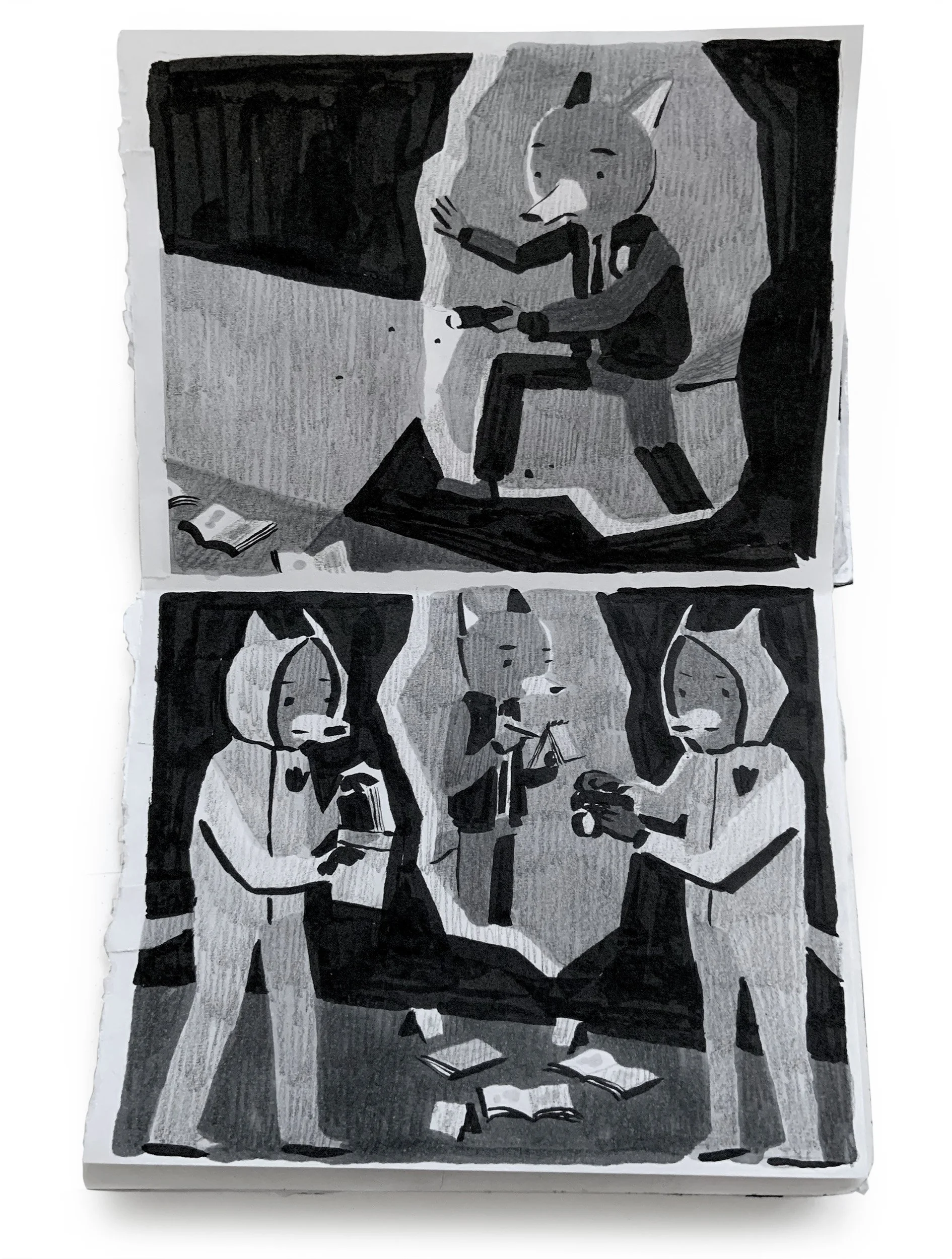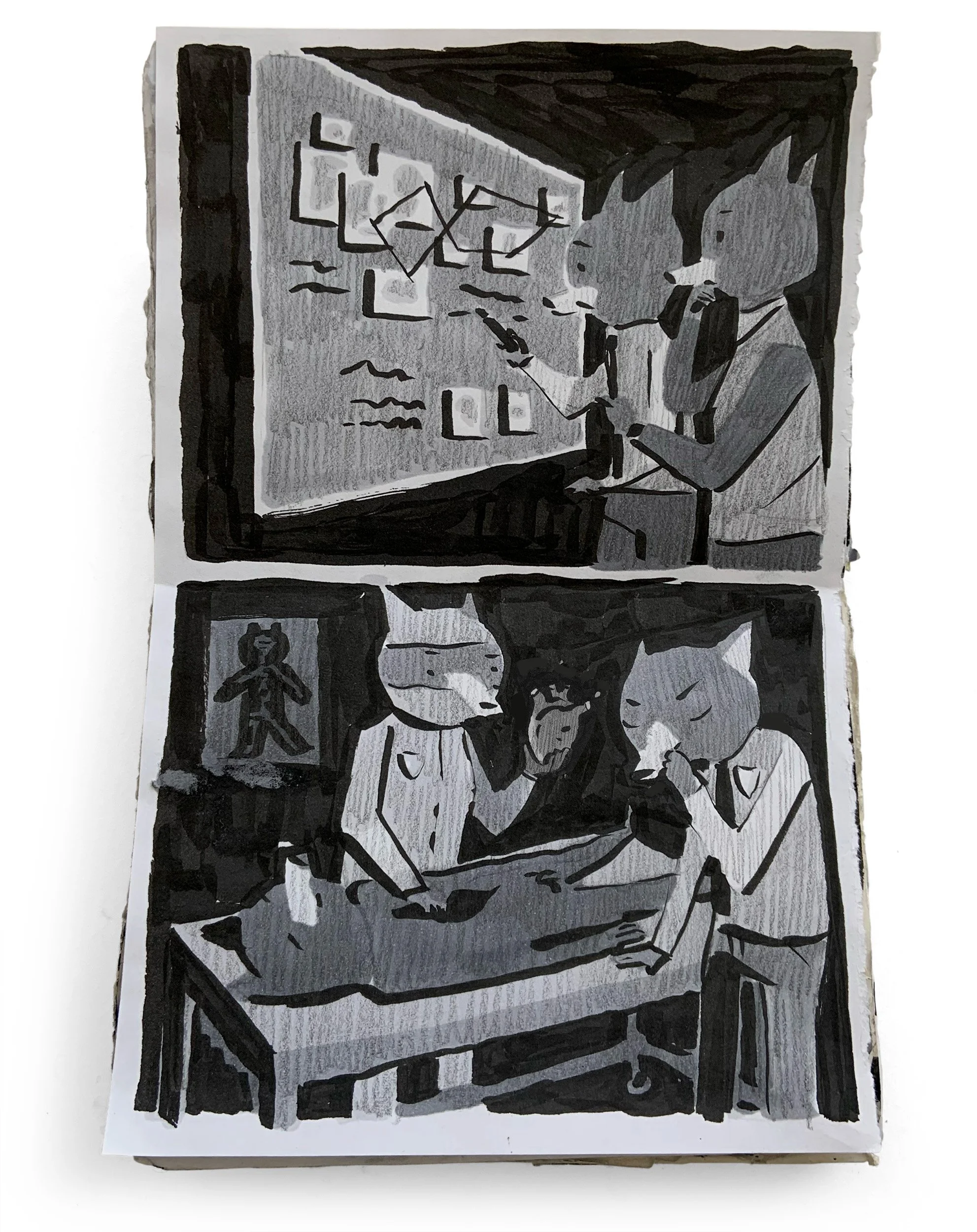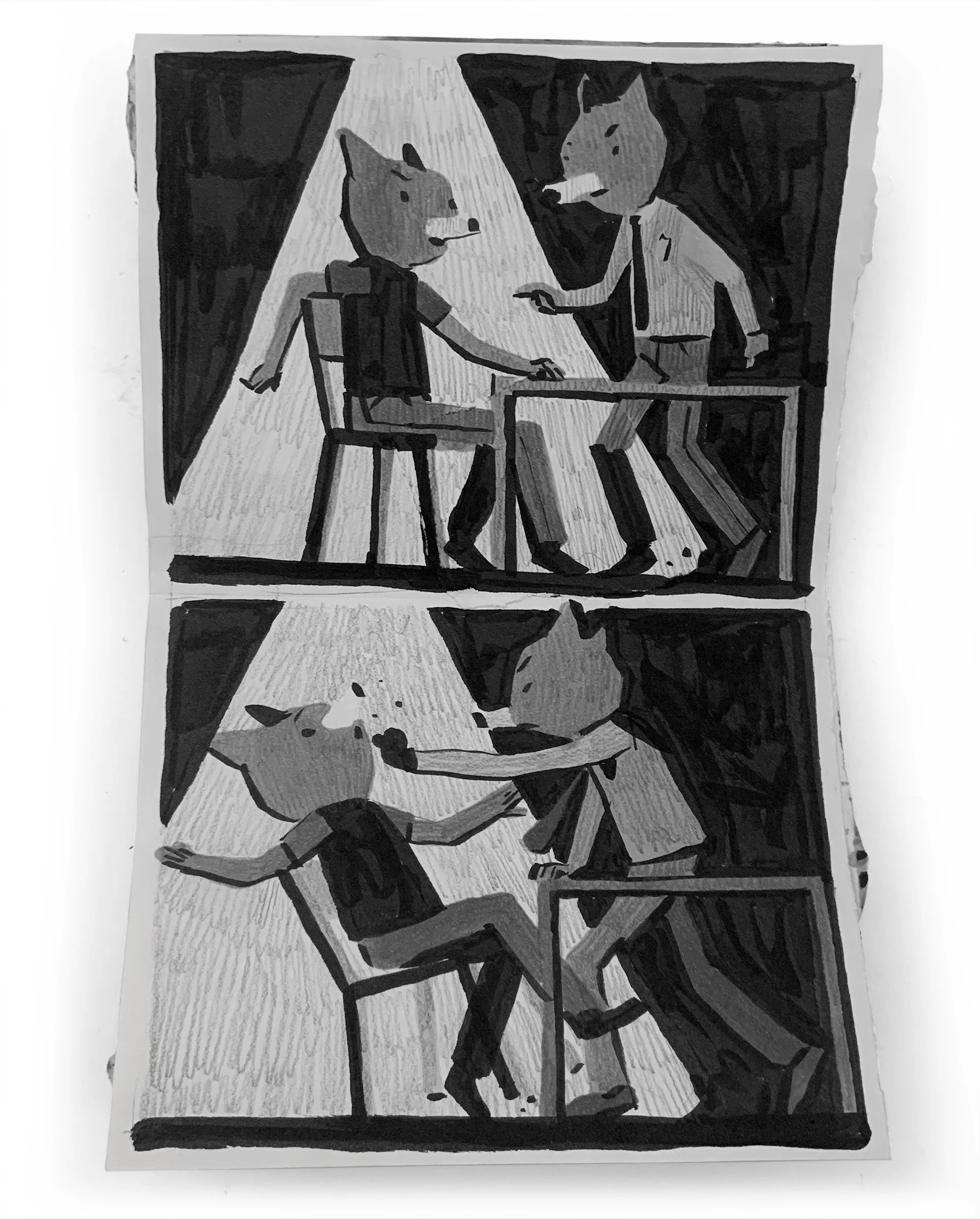Additional Reading / Chapter One
Warning: Contains descriptions of violence
A drawing NOIR
“Leafing through the interior of the book, a pattern was easy to recognize. The pages were filled with drawings of characters.”
the explosion
The sketchbook artist had his own way of doing things, a drawing routine he was comfortable with. Most days he felt confident about his drawings. Other times he wondered if he was just fooling himself. He was doing plenty of sketching, he had a treasure trove of overstuffed sketchbooks to prove it. Practice makes perfect they say, and he took that motto to heart. On a clear day everything seemed fine. However, anxiety inevitably darkened the horizon and too often the sketchbook artist lost his sense of direction.
It was during one of those dark days that the artist found a ray of sunshine peaking through the clouds of anxiety. He followed the glimmer of light. It led him to drawing something completely different. A new direction, and a new hope. As a result, his growth was explosive. For the first time he felt his work was going somewhere. The feeling was dynamite, and I’m not exaggerating when I say, “It blew his mind!”
the scene of the crime
The detective lifted up a small sketchbook. It looked handmade and well used. The cover, an unbleached paper, reminded the investigator of an old paper bag. Leafing through the interior of the book, the detective searched for a pattern. The pages were filled with drawings of characters. Some were cartoons, others were more representational. A mishmash of genres; futuristic robots, fantastical creatures, and lots of figures. Every other page was filled with gestural figure drawings. Occasionally the drawings were organized in sequences, panels that told fragments of half realized stories. However, one piece of evidence was missing, there were few indication of location in any of the drawings. No sense of place.
There were some feeble efforts at drawing environments scattered throughout the books. Hastily scribbled backgrounds squeezed around some of the character drawings. A silhouette of a tree, a stone arch, or a chair. But even to the detectives untrained eye they were half hearted attempts. Sketchy. The evidence was circumstantial, but it was compelling, the artist did not like to draw environments. And it wasn’t just the one book. There were dozens of sketchbooks that matched the pattern.
the modus operandi
Based on the evidence, the detective pieced together the serial sketcher’s method of operation. The suspects disinterest in figure ground relationships was obvious, the sketched characters had nowhere to go. The detective was not an expert on sketchbook artists, but he suspected this was not an uncommon trait. His gut told him that many artists were like the suspect, they disliked drawing environments. In his long career the detective had learned that most people were led astray because they took the easy way out, avoiding pain and seeking pleasure. Following the path of least resistance.
But then something changed. In more recent volumes an environment would break the figurative pattern. A few simple landscapes at first, and later a building. Even some interiors. Inevitably, more involved drawings began to appear in the sketchbooks. An establishing shot of a landscape to set up a scene, or a city street used to advance the plot of a story. Something had changed.
the suspect
He turned his attention to the perp seated at the interview table. The man looked dazed and tired. He leaned on the table, resting his elbows on it’s pitted surface. A mixture of spittle and blood dripped from the corner of his mouth. Adding color to the black and white sketchbooks scattered in front of him. The detective had already worked him over a bit, softened him up. Now he would go in for the kill.
“Tell me about these sketchbooks.” The detective said. Before the suspect could think to reply, the detective hit him hard in the face. The perp’s cheek swelled up from the impact. The dude was soft, it wouldn’t take much to get him to talk. “Tell me why you started drawing environments?” The detective asked, and this time he waited for an answer. “I don’t know, it just happened.” The man replied. The detective knew that there was more to the story, one of the suspect’s latest sketchbooks was filled entirely with environments, this went a lot deeper than just circumstance.
the interview
For a few moments, the only sound was the suspects harsh breathing and a steady drip of blood on the table. Until the truth finally trickled out. “I got bored!” The suspect blurted, “I was waiting in the car for my wife. I was sketching, but there was no one around to draw. And I didn’t have anything else in my head. The pages of the book had a grid so I just started drawing boxes. Then I started thinking of them as buildings. Usually I don’t like drawing buildings because perspective is such a pain, but when I thought of it as a game I didn’t mind it so much.”
The perp stopped talking and tried to compose himself. Too late, he was already broken. “They alway break.” thought the detective. He smiled, and switched to the good cop. He handed the man a few squares of soft tissues to stop the nose bleed. The wadded paper looked like a white rose turning red as it soaked in the blood.
“And then what?” The detective prompted. He leaned in, promising the return of the bad cop. The guy continued his confession without any more prompting. “I knew I needed to draw more than just people. I still didn’t like perspective so I said fuck it. I just drew scenes where everything floated, and gravity and perspective didn’t work the way it was suppose to. Basically I gave up on doing it right. It made drawing places easier, I didn’t have to think or struggle.”
the confession
The detective gave the man a pen and pad of paper and directed him to write out what had happened. After a few false starts, he could see the guy give in. He wrote that sketching environments gave his drawings purpose. Now, instead of just drawings of people, he included settings, times, and situations. Consequently, his drawings had places for the characters to go, to come from, or to leave. Situations and obstacles to overcome. It opened up a whole world of story possibilities.
After the sketchbook artist had finished writing his confession, he was left with nothing to do but regret. The detective watched the man through the one way mirror. At first the confessed drawer shrunk in on himself, a lost expression on his face. But then, like a light turning on, his eyes brightened. He opened an unfinished sketchbook to an empty page, and started drawing. The artist drew out his current predicament, including the table and the room. He also drew himself. Yet, it was the setting, with the dim lighting and hard angles, that got across the emotions of the situation. Providing context and narrative weight.
The detective sighed, the guy was in too deep. There was no turning back for him.
“In more recently completed volumes, an environment would break the figurative pattern. A few simple landscapes at first, and later a building. And even some interiors. Inevitably, more involved drawings began to appear in the sketchbooks. An establishing shot of a landscape to set up a scene, or a city street used to advance the plot of a story.”













